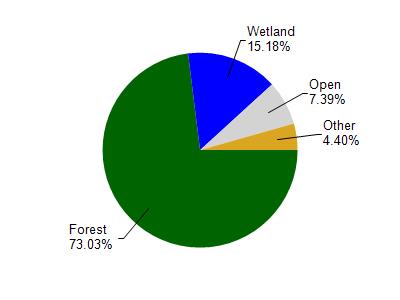Washburn
No
No
No
Fish and Aquatic Life
Overview
Middle Lake, in the Lower Namekagon River Watershed, is a 17.51 acre lake that falls in Washburn County. This lake is managed for fishing and swimming and is currently not considered impaired.
Date 2011
Author Aquatic Biologist
Historical Description
Source: 1978, Surface Water Resources of Washburn County Middle Lake, T41N, R13W, Section 2,
A small soft water, seepage lake situated between Upper Twin and Lower Twin Lakes. All three lakes are landlocked but a shallow channel connects the lakes during normal water levels. The fishery of Middle Lake includes northern pike, largemouth bass, bluegills, pumpkinseeds, white suckers and a few walleyes. Winterkill may occur occasionally and the panfish tend to be slowgrowing. The entire lake bottom is sandy and the lakeshore slopes steeply on much of the frontage. Aquatic vegetation is sparse. A three-acre marsh wetland borders the east end of the lake. The upland shore has mixed hardwood. A few puddle ducks nest off the lake but furbearer use is not significant. Private lakeshore development amounts to one resort between Middle and South Twin Lakes and five cottages. There is no public frontage on the lake but a town road crosses the channel to South Twin Lake and provides an unimproved public access to the channel.
Surface Acres-20.7, Maximum Depth-7 feet, M.P.A.-26 ppm, Secchi Disk-Bottom
Date 1978
Author Surface Water Inventory Of Wisconsin
Condition
Wisconsin has over 84,000 miles of streams, 15,000 lakes and milllions of acres of wetlands. Assessing the condition of this vast amount of water is challenging. The state's water monitoring program uses a media-based, cross-program approach to analyze water condition. An updated monitoring strategy (2015-2020) is now available. Compliance with Clean Water Act fishable, swimmable standards are located in the Executive Summary of Water Condition in 2018. See also the 'monitoring and projects' tab.
Reports
Management Goals
Wisconsin's Water Quality Standards provide qualitative and quantitative goals for waters that are protective of Fishable, Swimmable conditions [Learn more]. Waters that do not meet water quality standards are considered impaired and restoration actions are planned and carried out until the water is once again fishable and swimmable
Management goals can include creation or implementation of a Total Maximum Daily Load analysis, a Nine Key Element Plan, or other restoration work, education and outreach and more. If specific recommendations exist for this water, they will be displayed below online.
Monitoring
Monitoring the condition of a river, stream, or lake includes gathering physical, chemical, biological, and habitat data. Comprehensive studies often gather all these parameters in great detail, while lighter assessment events will involve sampling physical, chemical and biological data such as macroinvertebrates. Aquatic macroinvertebrates and fish communities integrate watershed or catchment condition, providing great insight into overall ecosystem health. Chemical and habitat parameters tell researchers more about human induced problems including contaminated runoff, point source dischargers, or habitat issues that foster or limit the potential of aquatic communities to thrive in a given area. Wisconsin's Water Monitoring Strategy was recenty updated.
Grants and Management Projects
Monitoring Projects
| WBIC | Official Waterbody Name | Station ID | Station Name | Earliest Fieldwork Date | Latest Fieldwork Date | View Station | View Data |
|---|
| 2482100 | Middle Lake | 10006939 | Middle Lake | 9/5/2000 | 9/15/2012 | Map | Data |
| 2482100 | Middle Lake | 663102 | Middle Twin Lake at Deep Spot | 7/25/1994 | 7/8/2022 | Map | Data |
|

Watershed Characteristics
Middle Lake is located in the Lower Namekagon River watershed which is 239.34 mi². Land use in the watershed is primarily forest (73.10%), wetland (15.20%) and a mix of open (7.40%) and other uses (4.40%). This watershed has 172.53 stream miles, 12,590.30 lake acres and 21,781.64 wetland acres.
Nonpoint Source Characteristics
This watershed is ranked Not Ranked for runoff impacts on streams, Not Ranked for runoff impacts on lakes and Low for runoff impacts on groundwater and therefore has an overall rank of Low. This value can be used in ranking the watershed or individual waterbodies for grant funding under state and county programs.However, all waters are affected by diffuse pollutant sources regardless of initial water quality. Applications for specific runoff projects under state or county grant programs may be pursued. For more information, go to surface water program grants.